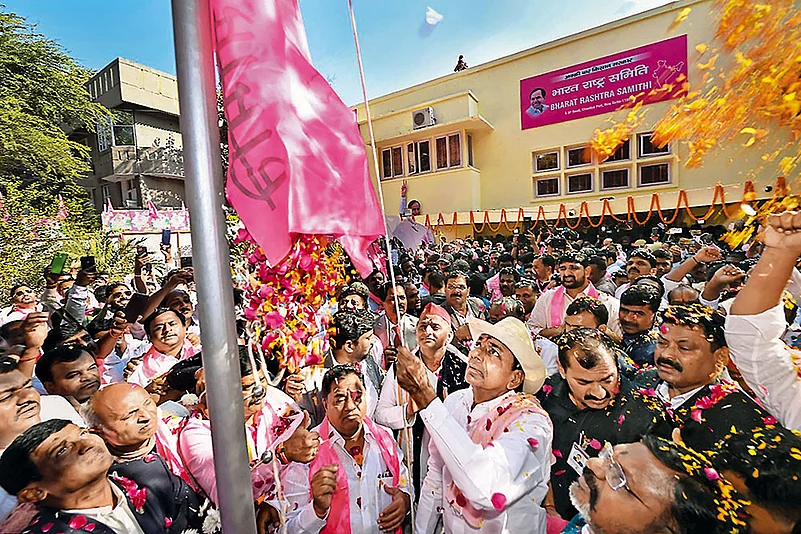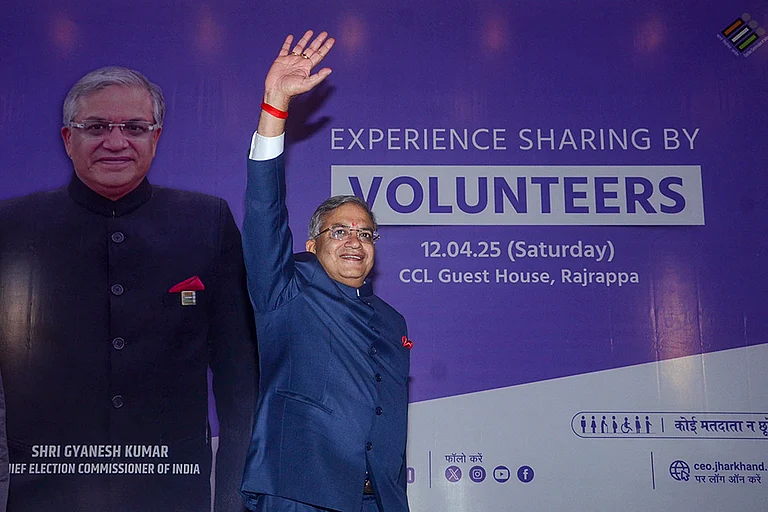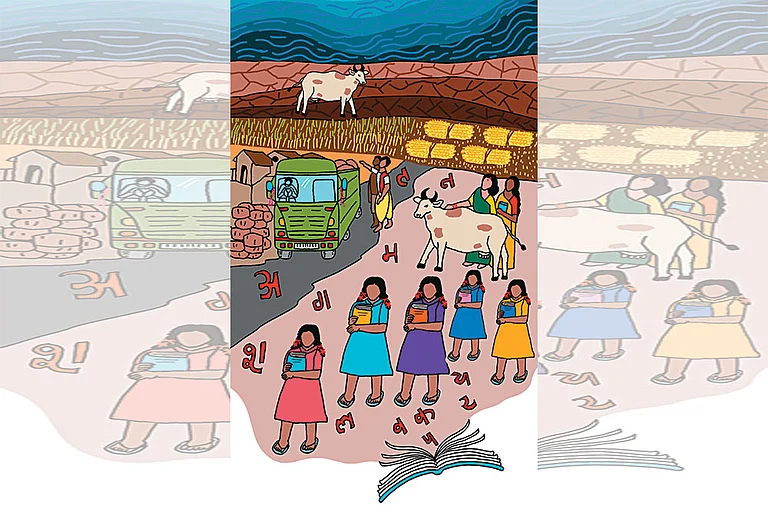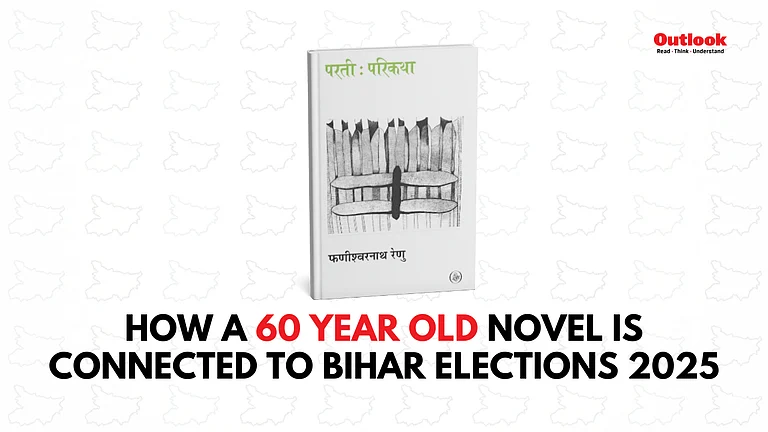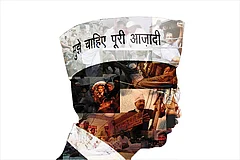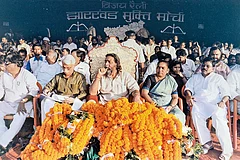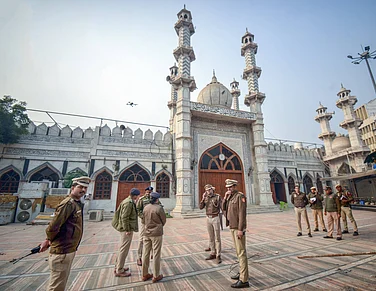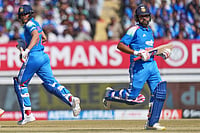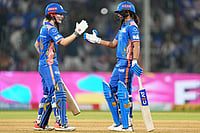“Galli mein bolo, Dilli mein bolo, Jai Telangana, Jai Telangana” (Say it on the streets, say it in Delhi, victory to Telangana, victory to Telangana). This was the slogan that student leaders, activists and supporters shouted in unison on June 2, 2014, when the 29th state was carved out of Andhra Pradesh. The landscape was pink, and it was in favour of Kalvakuntla Chandrashekar Rao, popularly known as KCR. The leader entered public and political consciousness with one aim, and with one aim only: to form a separate state for the four crore people who he said had been “discriminated” in undivided Andhra Pradesh.
His followers—from children to their grandparents—called him ‘Telangana Tiger’ and ‘Telangana Gandhi’; for them, the Telangana Rashtra Samithi (TRS) was synonymous with KCR. But now, the road ahead for this regional party appears to be difficult after the state voted out its ‘tiger’ in the 2023 assembly elections.
Once with the United Progressive Alliance (UPA), and then with the National Democratic Alliance (NDA), KCR formed the TRS (now Bharat Rashtra Samithi or BRS) in 2001 with the purpose of working towards a bangaru (meaning golden in Telugu) Telangana, wherein the social aspirations of marginalised communities would be fulfilled. It joined hands with the Congress-led UPA in 2004, and then with the BJP-led NDA in 2009, but both alliances didn’t reap any electoral dividends.
The party then fought alone and positioned itself as the flagbearer of social welfare by promising pension for single women, widows and senior citizens, double-bedroom houses to eligible residents and insurance for farmers. Hence, the party, over a period of time, had earned the tag of being ‘populist’.
It fought the 2014 and 2018 assembly elections largely on these populist welfare schemes and regional sentiments, which brought more success to the party than when it was part of any alliance. KCR and party leaders have repeatedly reminded their supporters of the “sacrifices” made by KCR to deliver them statehood. “Despite the Congress’ promise to form Telangana, the state became a reality only after our struggle for 14 years, and following my fast unto death deeksha (initiation) to press for statehood,” KCR said at an election rally last year in Hyderabad. Political experts believe that this factor largely worked in favour of the party that had been in power for almost a decade.
It secured a simple majority in 2014, winning 63 of the 119 seats, but managed to increase its presence to 88 seats in the 2018 elections—both times in alliance with Asaduddin Owaisi’s All India Majlis-E-Ittehadul Muslimeen, which has a strong presence in Hyderabad and several other districts with a large Muslim population.
The BRS fought the 2014 and 2018 assembly elections on populist welfare schemes and regional sentiments, which brought more success to the party than when it was part of any alliance.
BJP Makes Inroads
The political situation changed during the 2019 Lok Sabha elections. The new party was facing its first general elections. The BJP-led NDA government at the centre and their nationalistic stance overshadowed KCR’s regional sentiment—the saffron party won in four constituencies as compared to the 2014 elections when it won only one seat. In 2019, it registered a vote share of 19.5 per cent. Even though the BRS bagged the majority vote share (41.3 per cent), what came as a surprise was the BJP’s success in the northern regions of Telangana.
In Nizamabad, Adilabad, Karimnagar and Secunderabad—regions that witnessed communal clashes in the last decade—the BJP was accused of engineering polarisation during that year’s electoral campaign. But it was in these areas that the BJP scored big gains.

P Manikanta, a Hyderabad-based research scholar, wrote that one factor that might have worked is that the BJP, during the 2019 elections, brought the issue of threats being posed to the Hindu culture by the “others”. For example, after images of KCR and his party symbol (car) were inscribed on the pillars of a Hindu temple in Yadadri district, the BJP accused KCR of hurting Hindu sentiments. “Temples are not places for political propaganda. The chief minister should immediately get his images and the party symbols erased from the pillars. Else, Hindus know how to do that job,” BJP leader T Raja Singh had said in 2019.
Even in the last assembly elections of 2023, the BJP won eight seats as compared to the one seat it won previously in the northern regions of the state. Raja Singh too retained his Goshamahal seat from Hyderabad. Some of the constituencies where the BJP has seen gains—especially Nizamabad (Urban)—have a high Muslim population, notes academic and political analyst K Nageshwar in his analysis of the election results. “The BJP’s gains in these areas seem to be a direct result of communal polarisation,” he says. However, more votes for the BJP have come at the cost of the regional party.
Wobbly Stance
The BRS has often given mixed signals about its relationship with the BJP and its core agenda. For example, the BRS backed the saffron party in Parliament when it came to voting on key issues like the abrogation of Article 370. At the same time, it stayed away from voting on the Triple Talaq Bill in 2019. BJP General Secretary Ram Madhav had said: “Some parties helped pass the Bill by staying away. Those who can’t support Prime Minister Narendra Modi’s decisions openly, do so by staying absent.”

KCR ‘wholeheartedly’ supported the Union government’s demonetisation move in 2016, which, he said, was taken in the interests of the nation. But six years later, in 2022, his son and party scion, K T Rama Rao, termed it a colossal failure and urged the prime minister to apologise for the same.
Moreover, the party, which has significant support from the minority community in the state, had voiced its opposition to the Citizenship (Amendment) Act, 2019 (now passed), and the Uniform Civil Code (UCC). “The BJP plotted to instigate people by promoting divisive politics by raking up clashes between the communities to derive political benefits through the UCC bill,” a statement from the former chief minister said.
In the run-up to the assembly elections last year, the Congress party (then in opposition) even alleged that the BRS and the BJP had some form of a “tie-up”. In fact, days after the elections, which saw a rise in the vote share of the BJP, KCR’s daughter K Kavitha’s tweet on the newly-inaugurated Ram Mandir raised eyebrows about a possible alliance between the two parties for the forthcoming general elections. She had said: “Good development... the image of Sri Sitarama Chandra Swami in Ayodhya. At this auspicious time, when the dream of crores of Hindus is about to come true... it is to be welcomed by all the people of Telangana. Jai Sitaram.” She had earlier also called the inauguration a “dream come true for Hindus”. Her comment was seen as a major shift in the party’s stand on the issue, especially as KCR had raised the issue of the Babri Masjid demolition during the 2023 assembly election campaign.
“While initially, KCR’s sole intention was to fight on the basis of Telangana’s regional pride, it became evident in the past few years that his ambitions were changing,” says Ravichand of Hyderabad-based People’s Pulse, a group comprising politically engaged individuals working to understand ground-level dynamics. He recalls how KCR had once said: “For the sake of Telangana, I will join hands with the Maoists and the RSS.”

National Ambitions
Much ahead of the upcoming Lok Sabha elections, KCR had announced his plan of turning his regional party into a national one. His mission was to ensure that a non-Congress and non-BJP alliance would become the kingpin of the next general elections. So he changed the name of his 21-year-old party—from TRS to BRS—and announced its ambition of ‘bringing development’ to other states, including Maharashtra and Andhra Pradesh.
With this new vigour, the party held a public meeting in Khammam in January 2023. KCR, along with Pinarayi Vijayan from Kerala, Bhagwant Mann from Punjab and Arvind Kejriwal from Delhi, were seen holding hands and posing for a picture. They clearly laid down their common agenda: to fight the politics of “communal polarisation”. “If your (BJP) policy is privatisation, our policy is nationalisation,” KCR roared. He ended his speech with “Jai Bharat” instead of his usual “Jai Telangana”. But when the party couldn’t win in its own region, how can it go national? asks Ravichand.
“The TRS was born with Telangana sentiments and as soon as it was changed to BRS, that sentiment was lost,” says BRS leader Kadiam Srihari.
A year after this public show of strength, BRS’ national ambitions seem to have failed. “The TRS was a party born with Telangana sentiments and as soon as it was changed to BRS, that sentiment was lost,” former minister and BRS leader Kadiam Srihari admitted publicly at a meeting early this year.
MORE FROM THIS ISSUE
Maintaining a considerable distance from the BJP-led NDA and the INDIA bloc, the BRS has now decided to join hands with an unlikely partner, the Bahujan Samaj Party (BSP). The BSP, which failed to win even one seat in the assembly elections, has been a vocal critic of KCR and his “anti-Dalit” policies. Their next biggest challenge, Ravichand says, is to survive the upcoming Lok Sabha elections. “If they perform poorly, then there might be a break-up within the party, just like what happened with Shiv Sena,” he says.
(This appeared in the print as 'Hyderabad Blues')






